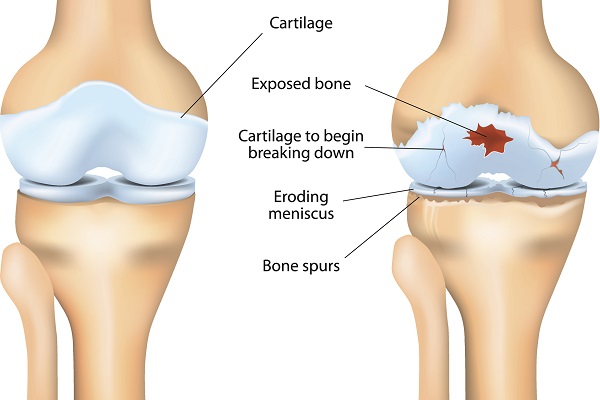Osteoarthritis (OA) is not only the most common chronic condition of the joints, but also the most common type of arthritis, affecting approximately 27 million Americans.1 The prevalence of OA increases with age,2 and elderly patients experience swelling, pain and decreased mobility. Currently, there is no cure for this degenerative joint disease, and the only therapeutics available consist of nonsurgical treatments tailored to pain control, such as non-steroidal anti-inflammatory drugs, joint replacement surgery and mobility aides. This is because the cells that make up cartilage have a more limited capacity for repair and self-renewal than those found in tissues such as bone marrow.3 Additionally, the lack of blood vessels in the cartilage found at the joints prevents the access of essential nutrients for appropriate healing. Thus, functional tissue cannot replace the damaged, senescent cartilage tissue and surgical intervention becomes the best solution.
Aged Cells Lead to Age-Related Disease
Senescent cells are normal cells that cease to divide but are still alive and metabolically active. They reportedly accumulate in various tissues in mammals — including mice, baboons and humans — as they age, contributing to tissue frailty and development of many age-related diseases. For instance, senescent cartilage cells known as chondrocytes have been observed in tissue obtained from patients undergoing joint replacement, but are absent in cartilage isolated from healthy people.4 In animal models of OA, transplantation of senescent cells from the ear cartilage of one mouse into the knee joint area of a different mouse led to the development of an OA-like illness.5 These transplanted cells caused leg pain, impaired mobility and erosion of the surrounding cartilage.
More About Rebuilding Tissue Cells from Dr. Jennifer Elisseeff, Ph.D.
Stopping or Reversing Osteoarthritis
What if it was possible to target and specifically eliminate these senescent cells as a new therapy for OA?
In an article recently published in Nature Medicine, Ok Hee Jeon and co-workers from the laboratory of Dr. Jennifer Elisseeff at the Johns Hopkins School of Medicine reported that OA could be stopped, or even reversed, when senescent cells were selectively removed from joints. In this study, the authors induced OA progression by performing an anterior cruciate ligament transection (ACLT) — a surgery in which the ACL is cut and nearly all supporting structures of the knee joint are destroyed — in genetically modified mice.
The mice were modified in a way that allowed their senescent cells to glow, letting these cells be noninvasively visualized. The transgenic mice were then injected with a drug called UBX0101 that triggered the death of senescent cells (a process known as apoptosis) and specifically eliminated them from the articular joints of the animals. To measure leg pain from OA, they used the “incapacitance test.” Here, each mouse paw is placed on separate scales. Normally the paws have equal weight balance. However, when injured, the mouse applies less weight on the paw that’s in pain — kind of like when you stub your toe.
Wiping Out Old Cells to Eliminate Disease
With this model, the researchers observed a reduction in cartilage erosion and hindlimb pain in the UBX0101-injected mice when compared to control mice that underwent ACLT but were not injected with the drug. This drug also showed efficacy in treating surgery-induced OA in wild-type and aged mice by selectively clearing senescent cells from the cartilage in their joints.
Furthermore, the authors validated the effects of this apoptosis-inducing molecule in cultured chondrocytes isolated from OA patients. Interestingly, the researchers not only saw a reduction in the percentage of senescent cells in chondrocytes from arthritic patients when they exposed them to UBX0101, but also confirmed the growth of new cartilage. Altogether, these findings indicate that specific removal of senescent cells from joint cartilage by inducing their death may provide new ways to target these cells as therapy for treating degenerative joint diseases such as OA.
This exciting work is of great relevance to the regenerative medicine field, specifically joint cartilage regeneration. Perhaps in a distant future, the senescent cells from the joints of patients who suffer from OA can be targeted and removed, providing an opportunity for their cells to repair the damaged cartilage and, hopefully, circumventing the need for canes, walkers or surgery.
References:
- https://report.nih.gov/NIHfactsheets/Pdfs/Osteoarthritis(NIAMS).pdf
- Felson DT, Lawrence RC, Dieppe PA, Hirsch R, Helmick CG, Jordan JM, et al. Osteoarthritis: New Insights. Part 1: The Disease and Its Risk Factors. Ann Intern Med. 2000;133:635–646.doi: 10.7326/0003-4819-133-8-200010170-00016
- Huey DJ, Hu JC, Athanasiou KA. Unlike Bone, Cartilage Regeneration Remains Elusive. Science (New York, NY). 2012; 338(6109):917-921. doi:10.1126/science.1222454.
- Price JS, Waters JG, Darrah C, Pennington C, Edwards DR, Donell ST, and Clark IM. The role of chondrocyte senescence in osteoarthritis. Aging Cell. 2002 Oct;1(1):57-65.
- Ming Xu, Elizabeth W. Bradley, Megan M. Weivoda, Soyun M. Hwang, Tamar Pirtskhalava, Teresa Decklever, Geoffry L. Curran, Mikolaj Ogrodnik, Diana Jurk, Kurt O. Johnson, Val Lowe, Tamar Tchkonia, Jennifer J. Westendorf, and James L. Kirkland. Transplanted Senescent Cells Induce an Osteoarthritis-Like Condition in Mice. The Journals of Gerontology, Series A: Biological Sciences and Medical Sciences, August 2016. DOI: 1093/gerona/glw154
Related Content
- Clearing Out Old Cells Could Extend Joint Health, Stop Osteoarthritis
Researchers find that removing senescent cells prevents joint degradation and promotes renewal in mouse joints - Premature Aging of Stem Cell Telomeres, Not Inflammation, Linked to Emphysema
